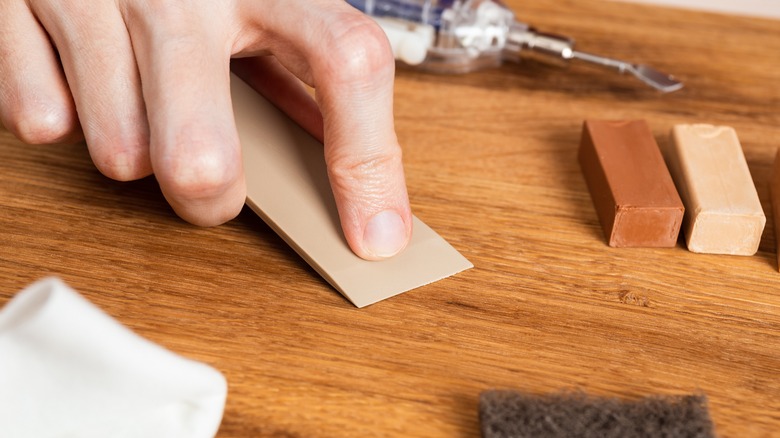Grab Super Glue And One Kitchen Ingredient To Seal Unsightly Wood Cracks
We may receive a commission on purchases made from links.
If you have wooden furniture that's been around for a while, then you have probably noticed some cracks around it and gotten finicky. Your engineered and solid hardwood can crack once it's been in use for a long time and potentially injure you with splinters and sharp edges. Replacing wooden furniture would be an expensive hassle, not to mention an assault on your emotions if it has sentimental value. If you don't see yourself giving up a chair, table, cabinet, or even flooring, you can use two unlikely ingredients to fill that crack right up: super glue and baking soda.
Wood cracks are caused by different factors. Sometimes, they're caused by the mishandling of furniture by its makers or the homeowner. In other instances, it's due to changes in the moisture and temperature levels in the environment. The wood contracts and expands naturally, and without proper reinforcements or expansion gaps in flooring, for example, it can crack. While baking soda and glue seem like an unhinged pair to fix wood cracks, you would be surprised how well these two ingredients combine to make an adhesive. Baking soda acts as an accelerant to the glue, and by mixing them together, you can create a makeshift wood filler to cover those cracks right up.
Fill the wood crack before sanding it down
Fixing cracked hardwood usually requires using wood filler, but with this trick, you can make it happen without running out to make a special stop. You can get Gorilla Glue on Amazon for $9. YouTube thrift-to-treasure DIY page Our Upcycled Life gives a helpful glimpse into how you can use this hack to fill up some wood in just a few steps. Make sure you have a portable sander in hand, or you can get a sheet of sandpaper, which costs just $7 for 120 sheets on Amazon.
Coat the wood crack with enough baking soda, even if it overflows. Make sure every bit of the crack is filled up. Then, polish off the excess and squeeze over some drops of super glue on it. Make sure you add enough glue to completely saturate every bit of the baking soda so that they react completely. You should instantly get a solid substance after that. Sand the area to level and smoothen the filler. You can choose to either paint over it or leave it as is. Unless your wooden furniture is as white as the filler mixture, you should definitely have some wood furniture paint on standby to make the situation much less noticeable.
